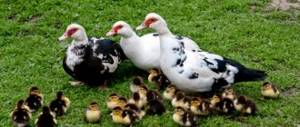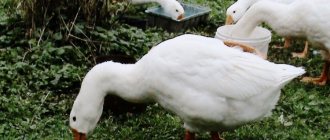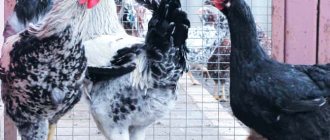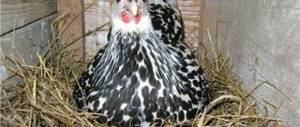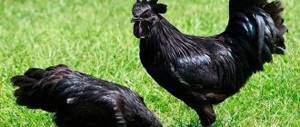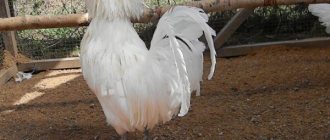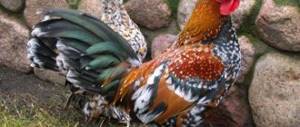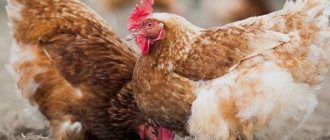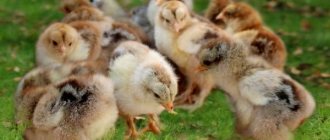Origin of the breed line
The ancestors of Hamburg chickens appeared around 1740 in Holland. These birds were very different from modern representatives of the breed in appearance and productive qualities. At that time, birds were delivered by traders from the Netherlands to Hamburg. The chicken aroused the interest of German breeders. They began working on improving the line. The original version of the breed, supposedly created on the basis of Cochin and Ramelsloer chickens, underwent the infusion of blood from the following varieties:
- lunar talakshiri;
- black Spanish;
- Yorkshire pheasant.
Representatives of the new breed line, which was later called the Hamburg line, inherited from their ancestors an attractive appearance, high egg production and the ability to adapt to various conditions.
Pedigree differences and description of Orpington chickens
The chickens got their name from the town of Orpington, Kent, UK. They appeared thanks to the efforts of breeder William Cook. He tried to obtain birds for home breeding that would meet the requirements of poultry farmers.
Initially, only black chicken colors were obtained, but over the years, after extensive breeding work, yellow, fawn, and red colors were developed. And relatively recently, in 1989, a new variety appeared - white. They differ from each other not only in color, but also in several parameters.
The chickens have become fat and are not laying eggs, you can find out what to do from this article.
Orpington chickens are visually distinguished from their relatives by their massive body. The body resembles a cube, on which hard plumage is densely planted.
Hens are smaller versions of roosters, with a more rounded belly and shorter stature.
In this article you can find out what to feed chickens to lay eggs in winter.
There are certain signs that lead to weeding out chickens:
- narrow body;
- white color on earrings;
- flattened breast;
- elongated tail;
- yellowness of the skin.
These chickens are friendly and have a calm nature.
In the video - Orpington breed of chickens:
Breed subspecies
Several types of chickens have been bred; they differ in the color of their paws, beaks and, most importantly, plumage.
The Jersey Giant chicken breed, characteristics and other data are indicated in the article.
Black
This is the first species that poultry farmers have developed. The black plumage has a greenish tint. Their skin is white. The metatarsus and beak are diametrically opposite in color - black, but the pupils can be dark brown. Birds with purple beaks, matte colors and red spots should be culled.
Golden
The belly of such birds is black with small areas of brown. The collar is golden in color with black stripes running parallel to the feather shaft. The bird's head is reddish-brown. And everything else is monochromatic, with each feather having a black border. Hens differ from cockerels precisely in this decoration. Birds have red or orange eyes.
Blue
Their body surface has a bluish-blue painting. The plumage has dark stripes. The tail is blue, and the loin and collar are bluish-black. The eyes are dark brown or black. The beak is dark gray, sometimes black. Birds with spots of a different color and red pupils are selected for culling.
White
They are completely snow-white, even their beak is the same color. The coloring of the eyes is similar to that of the golden species. Those birds that have yellowness in their plumage and red or blue streaks on their metatarsals are culled.
Fawn
It is also simply called yellow. The plumage has the color of old gold. The metatarsus and beak are white. The rooster will have a strong shine on the lower back and collar. Eye color is orange-red.
A bird is discarded from a purebred series if it has areas with a different color of plumage.
From this article you can learn about the description of the Brahma chicken breed.
Calico
Chickens of this subspecies are also known as porcelain and tricolor. The plumage is red-brown. At the end of the feather there is a black spot adjacent to the outer edge of a white dot, called the “pearl”. The wings have black feathers with white tips. The metatarsus and beak are snow-white.
Reds
They have a rich reddish tint, fading to brown. The down is red, and the beak and metatarsals are snow-white. The eyes are red-orange.
What the Australorp chicken breed looks like in the photo is indicated in this article.
Birds with a black or golden color, as well as if they have gray or white fluff, are considered for culling.
Partridge
This rare variety has complex colors. Representatives of this subspecies differ from each other. The cockerel has a golden neck and lower back. The feathers on the tail are black. The remaining feathers are golden in color with a brown edge. The hens have golden brown plumage, each feather has three black stripes.
What Bielefelder chickens look like is indicated here in the article.
Striped
Due to its unusual color and similarity to a bird of prey, the subspecies was given the name hawk. The feathers are black with a green tint and have whitish streaks on them. The metatarsus and beak are white.
Beauty and simplicity
They are classified as decorative. They are small in size, but are hardy, have excellent health and are famous for their productivity. But the most important advantage of Hamburg chickens is their unpretentiousness and excellent adaptability to practically any living conditions.
Hamburg chickens adapt well to any conditions
The ancestors of the “Hamburgers” appeared in Holland back in 1740. But the genus was far from perfect, its current appearance and modern characteristics. From the Netherlands the birds were sent to the port of Hamburg. German poultry farmers became interested in the breed. This cross (the so-called line of chickens that are bred specifically for certain properties inherent only to them), which is now known as Hamburg chickens, was obtained as a result of crossbreeding by crossing Cochins with Ramelsloers, diluted with the breeds Lunar Talakshire, Black Spanish and Pheasant Yorkshire.
Cochin is one of the ancestors of Hamburg chickens
In addition to the attractive, neat appearance, compactness and unpretentiousness, one cannot fail to note the main characteristics for which representatives of this breed are raised on farms. The birds are sporting and decorative and are characterized by high egg production.
Description of the breed
Hamburg chickens belong to the category of ornamental birds. As practice shows, despite their small size, representatives of this variety are very hardy and productive. In addition, they get along well with representatives of other breeds, which is undoubtedly a plus. Among other things, such birds are not particularly picky about their living conditions, which cannot but please farmers, and also have fairly strong health.
Breed standard
First, let's pay attention to the standard of the rooster. In males, the skull is slightly convex, oblong and graceful
The beak is shorter than long. The comb has a pink tint, is set evenly on the head, it is slightly wide in front, and tapers toward the back. Roosters have dark eyes and a generally red face.
The lobes of roosters are round, small in size, and tightly fitting. The neck is not long, but graceful; from the front you can see that it is slightly arched back. In general, the physique is slender, the back is wide, and the chest is like a wheel, raised high. As for the tail, it is long and bushy. The wings are also long, they fit tightly to the body.
If we talk about females, then Hamburg chickens are, in principle, very similar to roosters. Their body is located almost horizontally, elongated and has the shape of a cylinder. The tail is not like that of roosters, but short and compressed. the same goes for the comb and lobes - they are much smaller than those of males.
The abdomen is small but well developed. According to experts, purebred Hamburg chickens have tail feathers with a slight bend back. It should also be noted that their tail feathers are slightly elongated and narrow.
Appearance
Let's move on to the appearance of the Hamburg chicken breed. The first thing to note is that birds of this species have elongated and dodgy bodies. In general, the body is slightly lowered, the legs are not particularly long. Hamburg chickens have brightly colored feathers on their wings and tail; this is a distinctive feature. The skull is slightly tilted and the chest is raised up. The bird has no feathers on its face, but its head is characterized by hard plumage.
Representatives of this variety are characterized by a comb with a pink tint, in the middle of which there is a so-called tooth. The earlobes of birds are painted white, and the beak is bluish. The feathers on the wings are very long, and the wings are lowered down.
Hamburg chickens come in many colors, but the most common is silver spotted.
Origin
The North Sea coast is considered the homeland of Hamburg birds, and although this sea washes the UK and Europe, the breed was first bred in the Netherlands. Founded in 1740. The breed began to be called Hamburg because the Dutch sent chickens to the port of Hamburg. In fact, it was German poultry farmers who started breeding birds.
Initially, Dutch chickens were crossed with birds that had good health and good productivity, so that the variety was the most in demand. Hamburg chickens are the result of crossing conichines and ramelsloers. Later, representatives of the Spanish, Talakshire and Yorkshire breeds also participated in the formation of the final type of the breed.
A little history
Representatives of this breed were first seen in 1740. Despite this, Hamburg chickens gained popularity much later. The bird received its name due to transportation through the port of a settlement in Hamburg. Breeders in Germany began breeding birds. They really wanted to create a breed that would easily tolerate any climatic conditions and be highly productive.
Hamburg chickens were created by crossing several other species. Some breeds had good productivity, while others had an attractive appearance.
Origin story
Numerous images of the breed indicate that its first representatives were born back in 1740. However, the Hamburg breed gained popularity much later. The breed received the name “Hamburg” due to its transportation through the port of Hamburg.
The breed was bred in Germany, where breeders decided to create chickens that could easily withstand natural changes and climate difficulties, while having high productivity rates.
Success was achieved by crossing several breeds that have decorative properties combined with productivity. The greatest similarity with the appearance and productivity of Hamburg chickens is observed in the Turkish breed, described by the botanist Aldrovani.
Black Spanish, pheasant Yorkshire, and Lunar Talakshire breeds took part in the formation of the Hamburg breed.
Difference from other breeds
Hamburg chickens are easy to breed at home, on farms and farmsteads, in household plots and in summer cottages.
- If you compare them with other breeds, unpretentiousness and good adaptability to various climate conditions and its sudden changes can be considered a plus.
- But chickens have an average survival rate. In young animals it is 85%. Therefore, at the initial stage of growth, it is necessary to create comfortable conditions for the chickens.
- Also an undoubted merit of selection is the ability of Hamburg chickens to start the egg-laying period early. In laying hens it begins at 4.5 months.
- Finally, this is one of the rare aviary breeds that also does well when kept on the floor.
Hamburg chickens also do well when kept outdoors.
Despite the fact that the breed can live even in regions with harsh climates, you should prepare before adopting Hamburgers.
The fact is that chickens of this species do not sit on eggs. That is, they do not hatch chicks under any circumstances at all. This is probably the price of beauty and high decorativeness. If you are going to breed the breed yourself from eggs, you will need an incubator. If you buy day-old chicks, remember that with a survival rate of up to 85%, some of them may die even with excellent care.
To breed Hamburg chickens you will need an incubator.
Egg incubators
Prices for egg incubators
Egg incubators
Advice! The ideal place for keeping Hamburg chickens is a spacious aviary, which turns into a poultry house, where there are places for laying eggs and perches. Communication between these two parts must be free.
Spacious aviary with free access to the house
Advantages and disadvantages of the Orpington chicken breed
English Orpington chickens are moderately popular mainly among amateur poultry farmers. They value this bird for the following characteristics:
- Versatility. Since Orpingtons produce sufficient quantities of meat and eggs in equal measure, they are optimally suited for private households. Villagers do not need to have several breeds at once (separately for meat, separately for eggs), since Orpingtons are able to provide both in the volume necessary for family needs.
- Large carcass weight. This breed is interesting because from one chicken or one rooster you can prepare a large holiday dish, for example, a whole carcass baked in the oven. Smaller breeds are simply not suitable for this.
- Relative unpretentiousness. The rules for keeping and feeding Orpingtons are extremely simple and straightforward. Even those special requirements that apply specifically to this breed are not difficult to fulfill. In other words, keeping Orpingtons at home is not difficult at all.
- Calm disposition. It is very good that such massive birds have a balanced character. Given their weight, a bad temper could create a lot of problems for their owners. Fortunately, Orpingtons are calm and even phlegmatic.
As much as the breed is popular among amateur poultry farmers, it is also not popular among entrepreneurs, who generally avoid it. Even small farmers, not to mention large poultry farms, prefer other more productive breeds. This is due to the following disadvantages:
- Slow growth rate. Due to the fact that Orpington chickens do not grow fast enough, the cost of their meat in a commercial poultry farm is quite high. Even a large carcass weight does not cover the high costs of feeding.
- Tendency to obesity. Because of this feature of Orpingtons, it is impossible to stimulate their growth by increasing their diet. Birds simply get fatter, but do not accelerate muscle gain.
- Low egg production. Due to the presence of breeds that are more productive in this regard, the use of Orpingtons is less profitable in terms of profit.
Advantages and disadvantages
This breed has many more advantages than disadvantages. Even the meat of egg-laying chickens at the end of the active egg-laying period is not tough, has a pleasant taste and is quite suitable for food.
As for the main function of crosses - laying, in the first year the Hamburg laying hen is capable of laying up to 180 eggs, but there are individuals on farms that laid 250 eggs in the first year. All egg products are of an average standard - about 55 g in weight and have a snow-white shell. In dwarfs, the egg weighs 35 g. In the second year, egg production decreases to 140 eggs.
The Hamburg chicken egg has a snow-white shell.
The main positive characteristic is egg production, which is observed in any conditions. Since the “Hamburgers” calmly adapt to their environment, they are capable of laying eggs all year round.
Advice! To increase the egg production rate, it is recommended to create artificial daylight hours in winter using additional lighting for at least 14 hours.
Increasing daylight hours using artificial lighting will increase egg production
The second advantage among breeders and connoisseurs is considered to be high decorativeness.
Another important advantage is the compactness of the breed - smaller birds consume less feed.
The only disadvantages include a too short period of active egg production and a complete lack of instinct in laying hens to hatch eggs.
Hamburg chickens have no instinct to hatch eggs.
Features of Hamburg chickens, breed standard
The Hamburg rooster is graceful and fit, and a certain grandeur is visible in his appearance. The final accent of the appearance is a luxurious tail with long feathers. The birds are not large - the male weighs about 2.5-2.8 kg, and the laying hen weighs 2-2.2 kg.
Characteristics of the exterior of birds
Hamburg chickens have a memorable appearance, look at the photo. Let's look at the features of their exterior:
- a small head with a flat frontal part, covered with short feathers resembling bristles;
- bare, red face;
- the eyes are deep-set, the iris is colored reddish-orange;
- a rose-shaped comb, pointed at the back of the head;
- earlobes are white, earrings are oblong, red;
- the beak is small and light yellow;
- the torso is taut with an almost vertical stance, tapering downwards;
- the chest is raised high and protrudes slightly forward;
- the neck is long, narrow;
- well-developed large wings drooping down;
- fluffy tail with long braids;
- the legs are powerful, the metatarsals are unfeathered, gray-blue.
Hens are slightly smaller than roosters. They have a smaller crest, which in some individuals is almost invisible. The tail is thick and of medium size, forming an obtuse angle relative to the line of the back.
Feather color
The breed standard provides for 5 feather color options for Hamburg chickens. These include:
- black;
- silver striped;
- golden striped;
- silver spotted (pheasant);
- golden spotted.
The feather density is high, which makes it possible to breed Hamburg chickens even in regions with cold climates. Hens usually fledge faster than roosters.
Productivity indicators
Representatives of the decorative-sporting breed line grow at an average rate. At one year of age, the weight of a cockerel rarely exceeds 2.5 kg. Poultry is rarely used to produce meat, although the product has a pleasant taste and is quite suitable for consumption.
Hamburg chickens begin laying eggs at 4.5–5 months. During the first year of oviposition, they produce about 180 eggs, each weighing 50–60 g. The shell is white and durable. In the second year, the egg production rate decreases by 20%. To increase the egg production of laying hens, farmers must take care to provide birds with a varied diet and properly regulate the length of daylight hours.
Growing technology
Having chosen this breed for mass breeding, you need to prepare before you start purchasing young stock and starting breeding.
The first thing you need to take care of is the premises. This should be a poultry house (chicken coop, any autonomous utility room or a separate building in which the aviary is located. Preparations begin three days before the chickens move in.
You will need a room to keep chickens.
Step-by-step instructions for preparing a poultry house
Step 1 - liming
Three days before the planned planting of the birds, the walls, ceiling, and floor of the poultry house are covered with quicklime. It is left on surfaces for at least two hours.
Quicklime
Step 2 – disinfection
Limed surfaces and absolutely all surfaces from the inside of the poultry house are treated with formaldehyde.
Formalin is a disinfectant
Step 3 - ventilation
For this, three days are needed for sanitary and hygienic work - this is how long the room should dry out and ventilate.
Step 4 - filling the floor
A layer of fluff lime about a centimeter must be poured onto the floor under the bedding.
Fluff lime is poured under the bedding
Step 5 - litter
Pour directly onto the lime layer. May consist of large sawdust, wood chips or wood shavings.
Backfilling the litter
Important! Representatives of the breed feel good in almost any conditions, but their productivity can be significantly increased by placing no more than 15 heads per square meter.
Breeding Hamburg chickens: care recommendations
In order for chickens to be healthy and maintain their attractive appearance, it is necessary to create optimal conditions for them:
- the chicken coop should be clean, dry and warm;
- the room must be equipped with ventilation, lighting and perches of sufficient size;
- To prevent the bird from getting sick, the litter should be changed periodically;
- Regardless of the time of year, chickens should be allowed to range freely. In the cold months, its duration should be no more than three hours, and in the summer it is better to let it out for the whole day, while providing the bird with free access to the chicken coop.
Failure to follow these simple recommendations can not only lead to a significant decrease in productivity, but also to the development of various diseases that can cause complete extinction of the livestock.
Productivity
To date, the quantitative indicators of this breed are as follows:
- Grown-up chickens, whose age is from 1.5 to 2 years, have an average weight of about 1.7 - 2 kg;
- Roosters at the same age are approximately 2.6 kg.
- Egg production - one hen produces on average 180 eggs per year;
- The average weight of an egg is 50-60g.
In order to have Hamburg chickens on your farm, you need to prepare properly for breeding this breed.
Despite the fact that chickens grow very quickly, fatten quickly and are very unpretentious in care, poultry farmers must provide them with conditions that are most conducive to egg laying. We also draw your attention to the fact that the chickens themselves are not hens and do not “sit” on eggs.
Chickens, which quickly adapt to various changes, are distinguished by their enormous vitality. For them, it is enough to organize a free enclosure that smoothly turns into a poultry house, provide places for perching and provide poles made of sticks, natural beams or boards.
The ideal option would be a quiet, warm chicken coop, from which the birds could, if desired, go out into the fenced enclosure and look for insects there, “sweep up” litter, etc.
Malayan fighting cocks are one of the most fierce and powerful representatives of the fighting chicken breed.
If you decide to insulate your roof with foam plastic, then first you need to read the instructions!
This breed can be bred without problems in regions with harsh climatic conditions.
At the moment, the selection taking place with the Hamburg breed of chickens and their fellow Minorcas is in the development stage.
Description of appearance
The Hamburg breed of chickens has a small body, but the birds look proud, moving around the yard with an even posture and head held high. The head is small and looks proportional to the body.
Hamburg rooster
The rooster has a large pink-shaped comb, but in the hens it is less developed, also pink-shaped, but the back part is raised upward. In some females the crest is so poorly formed that it is practically absent.
The beak is short, slightly rounded downwards, and white. The eyes are small and dark. Facial skin is pale pink. The earlobes are large, especially on roosters. But they are white, like the plumage on the mane, so they are not noticeable.
The birds are small with a quirky body. The body is elongated, long and proud. The chest is wide, set forward, so it stands out well against the background of the body. The wings are small and tightly pressed to the body.
The thighs have powerful muscles. The metatarsus are high, not covered with feathers, and gray in color. The tail is bushy and straight and vertical in chickens. But the braids of cockerels are rounded and very long.
The plumage is very dense and does not allow cold to pass through. Chickens are characterized by interesting variegated colors. The head and mane are pure white or with black spots. But the coloring of the body is completely variegated. But the tips of the wings are always white. The tail, on the contrary, is white itself, but its ends are black.
Photo of this breed:
Rooster and female
Chickens for a walk
Chickens
Chickens of the Hamburg breed do not differ in appearance from the chicks of other chickens. Their coloring is light with several dark spots on the back and wings. The feet are not covered with feathers. They can be distinguished by gender from the first days of life.
You need to catch the chicken by the leg and turn it over: the cockerel will break free, but the chicken will remain motionless. The chicks develop very quickly. Down is replaced by feathers at 2 months.
Features of the initial stage of content
You can start purchasing a plant from the age of one day. It is optimal (financially) to start breeding from the age of the chicks in the range of 1-5 days, but not older than five. At an early age, chicks are quite susceptible to temperature and humidity, but later these indicators for the Hamburg breed will not be of decisive importance. At first, you need to make sure that the air temperature in the holding room is within +32°C, and the humidity does not rise above 70%.
Hamburg chickens
On the sixth day, the temperature drops by two degrees, the humidity remains unchanged.
Then, every five to seven days, the temperature in the poultry house should become two degrees lower, with a slight decrease in humidity - in general, gradually by 5-10% over five weeks. Humidity (unless it is elevated) is not a critical indicator. The temperature should in no case fall below +18°C, otherwise the chickens’ appetite will decrease, growth will noticeably slow down and overall development will slow down.
The temperature in the poultry house should be above +18°C
Content temperature table
| Age (days) | Temperature indicator (+°С) |
| 1-5 | 32 |
| 6-10 | 30 |
| 11-15 | 28 |
| 16-20 | 26 |
| 21-25 | 24 |
| 26-30 | 22 |
| 31-35 | 20 |
| 36-40 | 18 |
After the chicks are five weeks old, the temperature can always remain within +18°C, and the poultry house does not need additional heating.
Incubation
This breed is excellent for breeding in an incubator. Good hatchability does not require special conditions.
Table of temperature and humidity modes
| Period |
